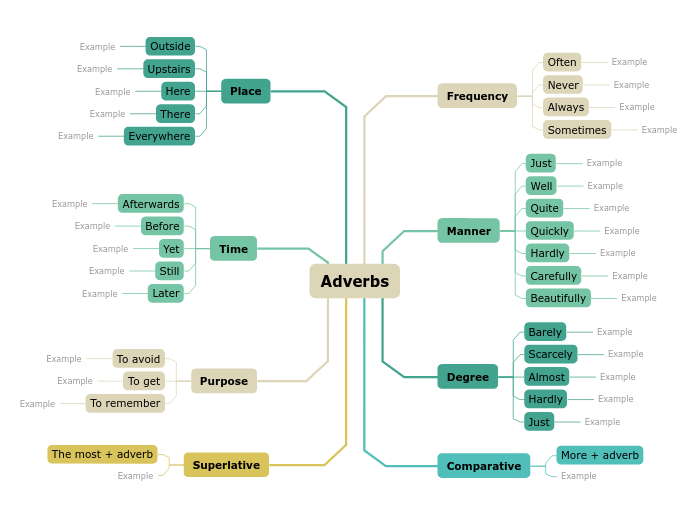English Adverbs Examples
Use this mind map to improve your understanding of how adverbs are used and practice by creating different contexts.
Keywords: grammar, language


More like this
Adverbs are the parts of speech that describe verbs, adjectives, or other adverbs, phrases, clauses, or sentences.
There are different types of adverbs:
Adverbs of frequency
Adverbs of manner
Adverbs of degree
Comparative adverbs
Superlative adverbs
Purpose adverbs
Time adverbs
Place adverbs
Adverbs of frequency present how frequently or how often verbs happen. Some examples of adverbs of frequency are:
Often
Never
Always
Sometimes
Adverbs of manner provide information about the way the verb is done. Some examples of adverbs of manner are:
Just
Well
Quite
Quickly
Hardly
Carefully
Beautifully
Adverbs of degree provide information about the level of intensity of verbs, adjectives, or other adverbs. Some examples of adverbs of degree are:
Barely
Scarcely
Almost
Hardly
Just
Comparative adverbs are used to show change or make comparisons. Comparative adverbs are formed by adding the word ‘more’ to adverbs.
Adverbs of purpose express the reason of verbs. Some examples of adverbs of purpose are:
To avoid
To get
To remember
Adverbs of time offer information about the time when the verb takes place. Some examples of time adverbs are:
Afterwards
Before
Yet
Still
Later
Adverbs of place offer information about the place where the verb takes place. Some examples of adverbs of place are:
Outside
Upstairs
Here
There
Everywhere
Adverbs are words or expressions that modify a verb, adjective, another adverb, determiner, clause, preposition, or sentence. Adverbs typically express manner, place, time, frequency, degree, level of certainty, etc.
Compares three or more things or people, usually is compounded of the words 'the most' plus adverb.
Answers the question:
Answers the question:
Answers the question:
Compares two things or people, usually is compounded of the word 'more' plus adverb.
Answers the question:
Answers the question:
Answers the question:
Write phrases as examples.
Mind maps help you brainstorm, establish relationships between concepts, organize and generate ideas.
However, mind map templates offer an easier way to get started, as they are frameworks that contain information about a specific subject with guiding instructions. In essence, mind map templates ensure the structure that combines all the elements of a specific subject and serves as a starting point for your personal mind map. They are a resource for providing a practical solution to create a mind map on a particular topic, either for business or education.
Mindomo brings you smart mind map templates that allow you to function and think effortlessly.
Descriptive topics
Topics with background text
Default branch
Removing the template data
You can choose from a variety of mind map templates from Mindomo's business or educational accounts, or you can create your own mind map templates from scratch. Any mind map can be transformed into a mind map template map by adding further guiding notes to one of its topics.